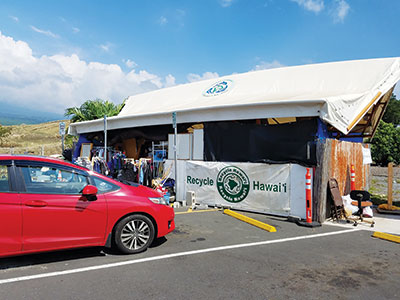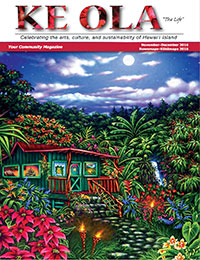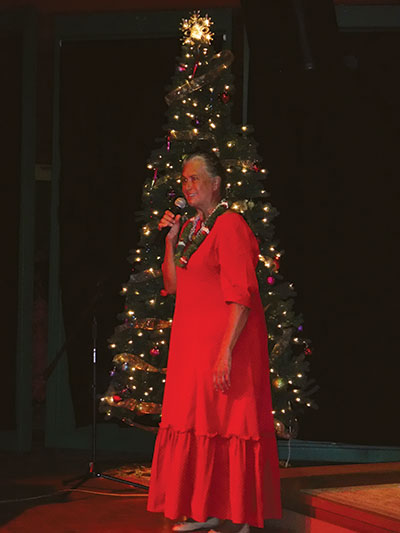
Recycle Hawai’i: Promoting Reuse in a Big Way
 By Paula Thomas
By Paula Thomas
Recycle Hawai‘i, a nonprofit organization based in Hilo, has a stated goal to increase resource awareness and to encourage recycling and sustainable practices in our community.
Its mission? To promote resource awareness and recycling enterprises in Hawai‘i.
On Hawai‘i Island, where there is no formal municipal waste pick up and a relatively short history of recycling, Recycle Hawai‘i has led the charge to educate about waste, implement recycling programs, and reduce the volume of waste that makes its way to our landfills through reuse programs.
According to the Final Report of the Big Island Reuse Feasibility Analysis prepared for the Clean Hawaii Center back in 2000, the “purpose of a reuse program is to capture used, and certain new items and materials that still have some useful life, before they reach a county landfill, and return them to productive use.
Reusable items may be: Used items that are in good enough condition to continue serving their originally intended functions or alternate functions. Used items that can serve as sources of spare parts for similar items. New items that cannot be sold as new for various reasons (e.g., blemished, damaged, out of date, discontinued, low demand), yet can still serve originally intended purposes or alternate purposes.”
The key features of a recommended reuse program, according to the Report, are what more or less became the guide for the first reuse/recycle center on the island set up with USDA funding.

In 2003, Recycle Hawai‘i and the County opened the Kea‘au Reuse and Recycling Center (KRRC). Today, KRRC is the flagship reuse center on the island with sister centers in Pāhoa, Keauhou, Kealakehe, and Waimea.
Over the past two years, KRRC and the Pāhoa station diverted a monthly average of 23 tons of reusable material from the East Hawai‘i landfill for a total of 560.5 tons, with 461.3 of that attributed to KRRC alone.
The story in West Hawai‘i is similar: more than 280 tons were diverted from the landfill with the Waimea Transfer Station accounting for about half of that.
The beauty of these reuse stations is that people can bring ALL unwanted household items to one location (the transfer stations). Their bottles and cans go to the HI5 receptacles; newspapers and cardboard and greenwaste go into appropriate containers.Now items like clothing, hardware, recreation, sports and training equipment, electronics, books, latex paint, and “miscellaneous household” can be dropped off at the reuse stations. Once it’s sorted, anything reusable is for sale.
At KRRC, there’s a solid wall of books. Clothing is displayed on beautiful racks thanks to the closing of Sports Authority. In the construction area, there is lumber, PVC pipes, and joints cached adjacent to a cluster of porcelain toilets, and lots of latex paint is available by the gallon and five gallon container.
KRRC has the largest expanse of land and so is conducive to the storing and stacking of construction equipment. The other reuse centers are much smaller. Some are just bamboo shelters not equipped to take in construction materials, at least not at the present time.
Wherever possible, however, Recycle Hawai‘i has a storage container available to house all other donated items so they can be kept safe and dry before being sorted and resold. At some of the centers, especially Kealekehe, there just isn’t enough capacity (even with the container) to accommodate all the donations. Any excess gets hauled to KRRC.
For the staff at all locations, sorting through all the donations takes up the bulk of their time, yet it is essential for their mission: to divert as much from the waste stream as possible.
What can get resold or reused is put out for sale, and the rest gets “thrown away.” Let’s be clear, there’s no “away.” Away means it’s bound for the landfill. In three years or so, the landfill will be full, according to Paul J. Buklarewicz, executive director of Recycle Hawai‘i.
The reuse program is a win-win-win for Recycle Hawai‘i, the community, and Hawai‘i Island. Recycle Hawai‘i generates revenue from sales. The community has new access to low-cost items that can be used or repurposed, and less waste makes its way to the landfill. That is the overarching goal.
So, if it happens that you or someone you know are looking for really low-cost items, visit the reuse centers. At most centers, the clothing is free on Thursdays, and the Kea‘au location also offers free clothing on Mondays. Get there early!
On all other days, everything is for sale at bargain-basement prices. Clothing goes for $1 for five pounds and $5 for up to 50 pounds. The big scale is right by the cashier desk.
There are mothers with children who shop for clothes and toys, young people looking for home accessories, women who shop for handbags and accessories, people browsing books, tools, checking out the workout equipment.
These stations are open seven days a week during business hours (8am to roughly 5pm—see the sidebar for exact times and directions) and open every day of the year except Thanksgiving, Christmas, and New Year’s Day. They are situated at the transfer stations, so they can be readily discovered.
If you haven’t noticed them, look for the bamboo shelter at Keauhou, Kealakehe, and Pāhoa. At Waimea, it’s the small building that is used by both Recycle and the HI5 program. At Kea‘au, you can’t miss the enormous shelters. They came from one of the County departments and call direct attention to the reuse program.
For those who want to donate, you can simply bring unwanted clothes, old gym equipment, baby paraphernalia, used books, old kitchenware—almost anything reusable—to Recycle Hawai‘i and you will get a donation form in return. Bring useful items that will provide new owners with either cost-effective, energy-efficient, and/or reliable service benefits.
The staff are helpful and accommodating, passionate about what they do, highly empathetic, and dedicated to the community. There isn’t much they won’t do to assist people in finding what they need. Some of them rarely take a vacation.
At KRRC, in front of the reuse area, there are three HI5 recycle bins that are just for Recycle Hawai‘i. Put your bottles and cans in those bins—and you are supporting the staff Christmas party, a Thanksgiving gathering, or a pau hana (after work) event.
Diversion
It was determined in 2015, that about 54% of the Hilo landfill is composed of organic waste. Diverting that organic material is in the near-term plans and a $10 million initiative was recently announced for a massive composting program. That means one day you could be going down to the reuse station for your mulch!
In 2008, Recycle Hawai‘i began working to collect materials from renovated buildings and new construction sites with the idea of reselling construction and demolition materials. In one six-month period in 2009, Recycle Hawai‘i was able to divert 200,000 pounds of material from the landfill. To put that in perspective, a doublewide mobile home weighs about 120,000 pounds. The space shuttle weighs in at about 165,000 pounds.
Now, seven years later, Recycle Hawai‘i is working through the Leadership In Energy and Environmental Design (LEED) program to identify LEED construction projects around the island. LEED guidelines require that a certain percentage of material is recycled, and the higher the LEED rating for the project, the more that has to be recycled.
Recycle Hawai‘i, with its main office in Hilo, has run tremendous educational programs on how and why to recycle, reuse, and compost. It’s developed outlets all around the island for the proper disposal of all kinds of hazardous and non-biodegradable waste, from used motor oil to electronic waste, all for the purpose of preventing unnecessary disposal of items into the landfill. This saves us all money (estimated at roughly $80 per ton), conserves landfill space, and provides low-cost items for anyone interested. It also prevents hazardous and toxic waste from causing undue harm.
Its programs have been so successful and artfully creative that their outreach is still a fixture in the schools.
It was many decades ago that recycling as a community and household responsibility started to take hold across the United States. Conversations about waste disposal called attention to the words used to refer to waste removal, like throw out the trash, throw away the garbage. Trash is the stuff you get rid of because it is no longer wanted or needed; garbage is discarded animal and vegetable matter, as from a kitchen; or any matter that is no longer wanted or needed.
All this we get rid of by throwing it “away”, forgetting that there really is no “away” when you live on an island. Unless we are jettisoning all of our trash and garbage into outer space, “away” is simply a euphemism for the fact that we give our garbage to someone else to deal with. All of the “stuff” that you throw “away” goes somewhere, and if your stuff is not biodegradable, it’s going to be at that somewhere for a long, long time.
Resource management, instead of waste management, has become a new focal point for planning. The County of Hawai‘i supports the reuse and recycling efforts across the island, and even more could be done more quickly with a bigger budget.
According to an article in Waste to Wealth, “Recycling has become… a permanent part of U.S. daily life. More people recycle every day at home, school, and work than vote regularly in elections. The impact has been dramatic.” There is more we can all do. It starts with thinking about what we do with things we no longer want before we throw
them “away.”
If it’s usable, take it out of your garbage bags and bring it to a Recycle Hawai‘i reuse station instead. You’ll be doing yourself, Recycle Hawai‘i, and our island a great service.
Mālama Nā ‘Āina: Reduce, Reuse, and Recycle ❖
Contact Recycle Hawai‘i: RecycleHawaii.org, 808.969.2012
Contact writer Paula Thomas: paula@delphipacific.com
Photos courtesy Recycle Hawai‘i
Sources:
RecycleHawaii.org/recycle-reuse-centers.html
BountyHeadbBeBop.com/forum/index.php?topic=24.0
ILSR.org/the-new-recylcing-movement-part-1-recycling-changes-to-meet-new-challenges


